Table of Contents Show
I. Introduction
Deep Learning and Machine learning are both important parts of this artificial world. Before we talk about ‘Deep Learning vs Machine Learning’, we need to know more about these in detail. Machine Learning (ML) is a field of artificial intelligence that utilizes statistical techniques to allow computer systems to “learn” from data without being explicitly programmed. The concept was first coined by Arthur Samuel in 1959. It has since become one of the most exciting areas of AI, transforming numerous industries with its potential to automate decision-making processes. AI in ML has several benefits.
Deep Learning, a subfield of machine learning, takes inspiration from the human brain to process data through layered structures of algorithms called neural networks. Each layer processes information, passes it to the next layer, and so forth until the final output is produced. This method allows for much greater processing power, and as a result, Deep Learning can make sense of complex, unstructured data that would be challenging for other ML techniques.
The purpose of the article: Deep Learning vs Machine Learning
This article Deep Learning vs Machine Learning aims to demystify the often blurred lines between ML and Deep Learning, providing a clear understanding of the unique characteristics, capabilities, and applications of each. It will explore their fundamental differences, strengths, and weaknesses, ultimately helping readers make informed decisions about which approach might be best for their specific needs.
II. Understanding Machine Learning
A. Detailed explanation of Machine Learning
1. Supervised Learning
Supervised learning is a type of machine learning where the model is trained using labeled data. In other words, the model learns from data that includes both the input and the correct output, allowing it to understand the relationship between the two and make accurate predictions for new, unseen data. This method is commonly used in applications like fraud detection, email filtering, and regression tasks.
2. Unsupervised Learning
In unsupervised learning, the model is given unlabeled data and must find patterns and relationships within the data itself. This technique is often used for clustering (grouping similar items) and association tasks. It’s useful in exploratory analysis or when we don’t know what we’re looking for.
3. Reinforcement Learning
Reinforcement learning is a type of machine learning where an agent learns to behave in an environment by performing certain actions and observing the rewards/results that it gets from those actions. It’s particularly suitable for situations where we want to automate decision-making and is often used in gaming and navigation applications.
B. Common applications of Machine Learning
Machine Learning has a wide range of applications, from email spam filters and recommendation systems (like those used by Amazon or Netflix) to credit card fraud detection and self-driving cars. It’s also used in healthcare for disease prediction and diagnosis and in finance for predicting stock prices.
C. Advantages and Disadvantages of Machine Learning
Machine Learning’s main advantage is its ability to automate decision-making and prediction processes, which can greatly improve efficiency and accuracy. However, it requires significant amounts of labeled data for supervised learning models, and the models can often be difficult to interpret. Furthermore, machine learning models may overfit the training data and perform poorly on new, unseen data. Nonetheless, the benefits can far outweigh the potential drawbacks with the right data and careful model selection.
III. Understanding Deep Learning
A. Detailed explanation of Deep Learning
Deep Learning is a subset of machine learning that utilizes a hierarchical level of artificial neural networks to carry out the process of ML. Artificial neural networks are built like the human brain, with neuron nodes connected together like a web.
1. Neural Networks and their layers
Neural Networks, at the core of deep learning, are algorithms designed to recognize patterns. They interpret sensory data through a kind of machine perception, labeling or clustering raw input. These networks consist of multiple layers of nodes (or “neurons”), each performing a simple computation. Each layer’s output is the subsequent layer’s input—much like an assembly line. The layers between the input and output layers are called hidden layers.
2. Convolutional Neural Networks (CNN)
Convolutional Neural Networks are a type of deep learning algorithm that is particularly powerful for tasks involving spatial data, like images. CNNs have their “neurons” arranged more like those of the frontal lobe, the area responsible for processing visual stimuli in humans and animals. CNNs are widely used in image and video processing applications to understand the spatial hierarchies in a scene.
3. Recurrent Neural Networks (RNN)
Recurrent Neural Networks are designed for sequential data, where the order of inputs matters. Unlike traditional neural networks, RNNs have ‘memory‘ in the form of loops that allow information to be passed from one step in the sequence to the next. This makes them ideal for tasks like natural language processing, speech recognition, and time series forecasting.
B. Common applications of Deep Learning
Deep Learning is commonly used in a variety of fields, including natural language processing, speech recognition, image recognition, and even in self-driving cars. For example, Google’s search algorithm uses deep learning to improve its results, and Facebook uses it to recognize and tag faces in photos. Deep learning has also been used in healthcare to analyze medical images and assist in diagnosis.
C. Advantages and Disadvantages of Deep Learning
Deep Learning can process a huge amount of data with a large number of variables, making it ideal for large-scale, complex tasks. It’s also exceptionally good at handling unstructured data, such as images and text. However, deep learning models require significant data and computational power. They also require a lot of fine-tuning and time to train effectively. Furthermore, the ‘black box‘ nature of deep learning can make the outcomes difficult to interpret and understand, which can be a drawback in fields where interpretability is essential.
IV. Deep Learning vs Machine Learning: The Key Differences
A. Complexity and processing power requirements
This is the most important factor when we talk deep learning vs machine learning. While both machine learning and deep learning require processing power, deep learning particularly requires much more due to its complex neural networks with many layers. Machine learning algorithms are generally more straightforward, making them less computationally intensive than deep learning.
B. Data handling and performance
In terms of data handling, machine learning typically works well with structured and semi-structured data, while deep learning excels at working with unstructured data. When it comes to performance, deep learning algorithms typically improve as the size of the data increases. In contrast, machine learning algorithms may plateau after a certain point.
C. Interpretability and transparency
Machine learning models, especially linear models, are usually easy to interpret. You can understand the predictions by looking at the feature weights. On the other hand, deep learning models are often considered as “black boxes”. While they can deliver high accuracy, it’s usually hard to understand why a deep learning model made a certain prediction.
D. Required amount of data
Machine learning algorithms often work well with relatively small datasets. Conversely, deep learning requires large amounts of data (and in many cases, a lot of computational power) to perform optimally.
E. Usage scenarios for each technique
Machine learning is often used in applications where interpretability and ease of implementation are critical, such as predictive maintenance and fraud detection. Deep learning is commonly used in unstructured data applications, like image and speech recognition.
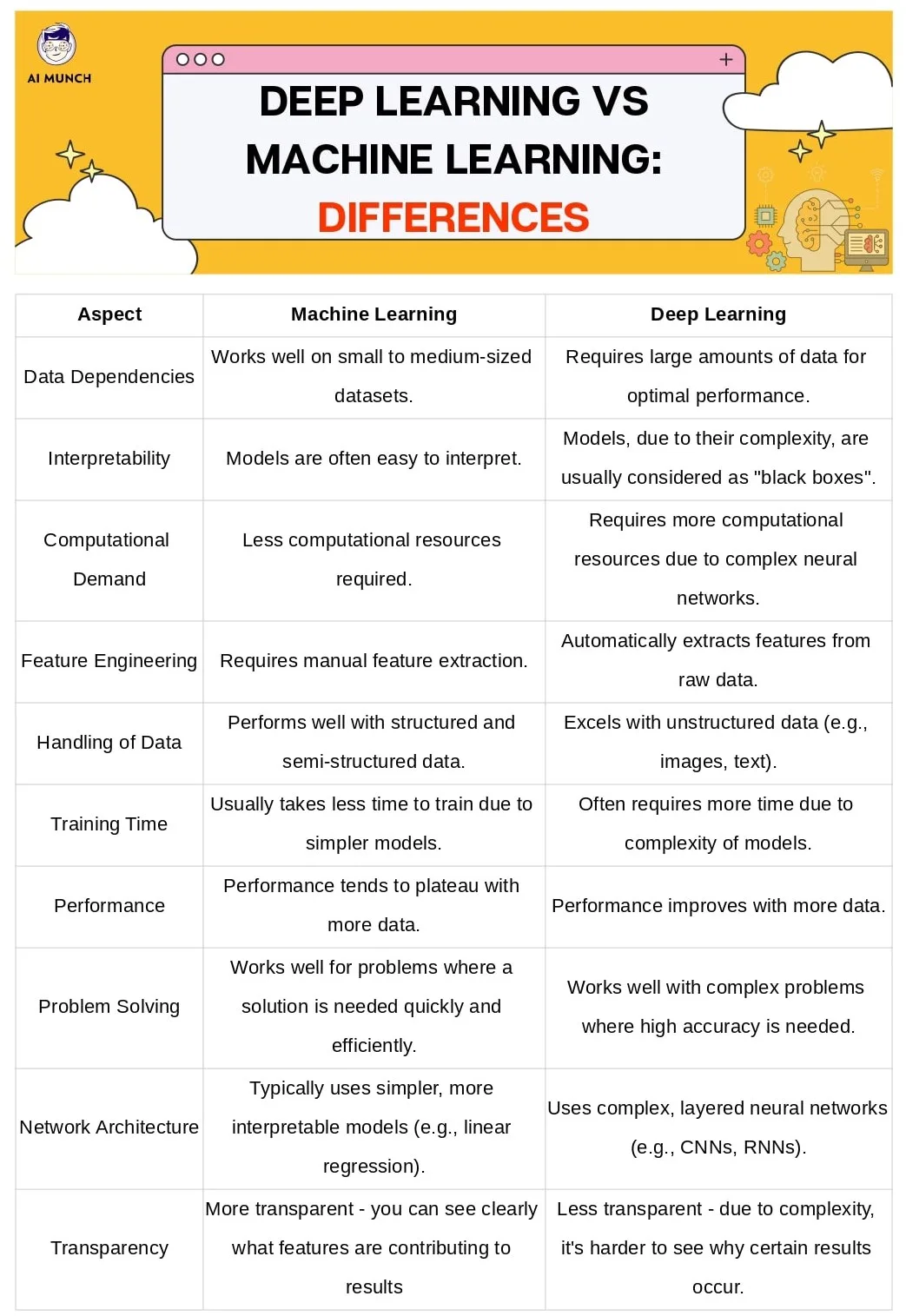
V. Case Studies: Comparing Deep Learning and Machine Learning in real-world applications
A. Case Study 1: Image Recognition
In image recognition, deep learning algorithms, specifically Convolutional Neural Networks (CNNs), often outperform traditional machine learning algorithms. They can automatically learn to recognize complex patterns in images and achieve high accuracy.
B. Case Study 2: Natural Language Processing
In Natural Language Processing (NLP), both machine learning and deep learning techniques are used. However, deep learning, with techniques such as Recurrent Neural Networks (RNNs) and Transformers, has revolutionized NLP, enabling sophisticated applications like machine translation and sentiment analysis.
C. Case Study 3: Predictive Analytics
Due to their interpretability, traditional machine learning techniques like linear regression and decision trees have been widely used in predictive analytics. However, deep learning can provide more accurate predictions for complex prediction tasks involving high-dimensional data, albeit at the cost of interpretability and computational efficiency.
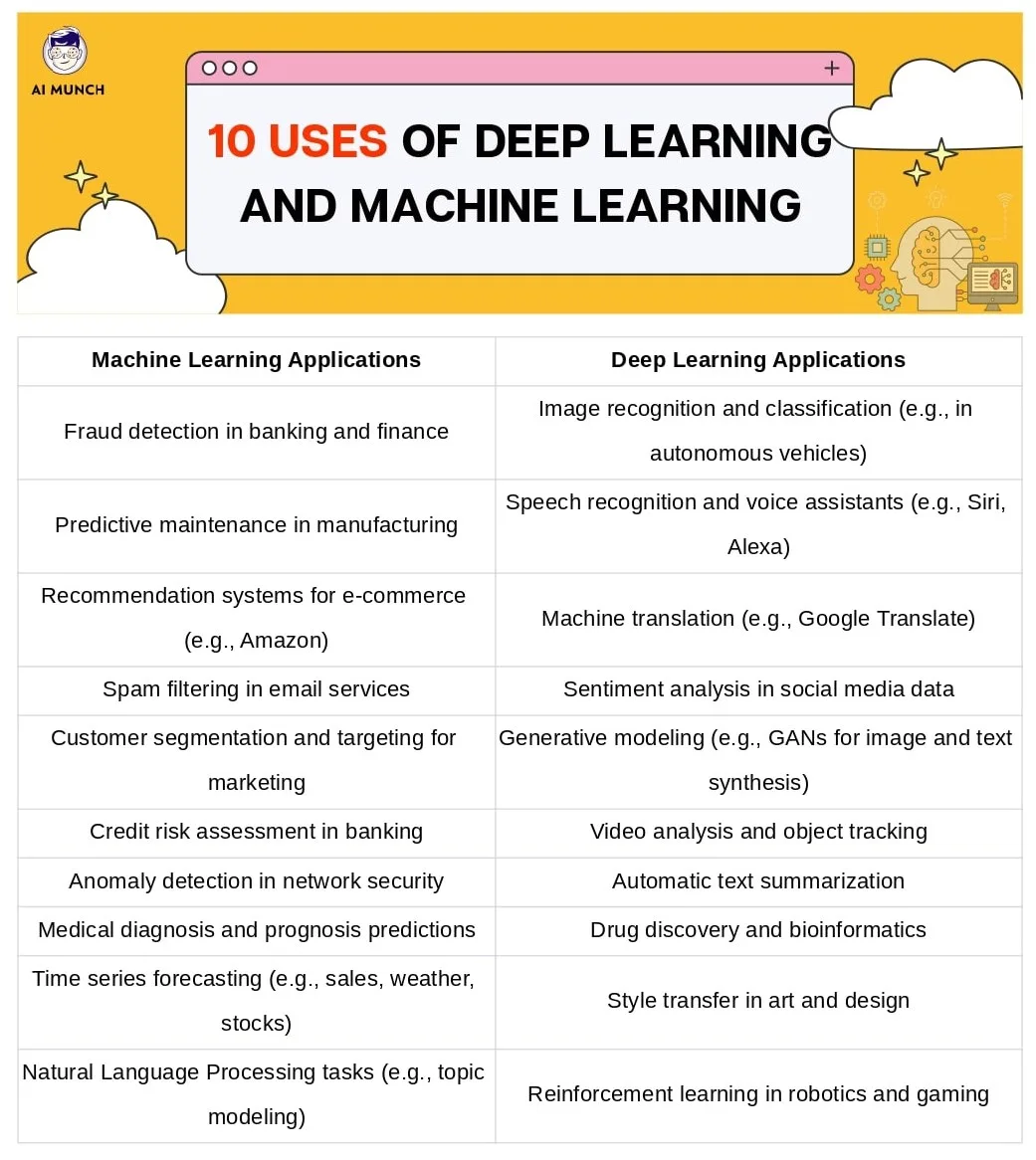
VI. Choosing Between Deep Learning and Machine Learning
A. Factors to consider when choosing between Deep Learning and Machine Learning
The choice between deep learning and machine learning depends on several factors, including the problem’s nature, data availability, the model’s interpretability, and the computational resources at hand. For instance, if you have a small dataset, machine learning algorithms might be more effective. On the other hand, deep learning might be the better choice if you have a large dataset with high dimensional input data.
B. Role of business requirements and resources in making a choice
Business requirements and resources play a crucial role in determining whether to use deep learning or machine learning. Factors to consider include the problem’s complexity, the need for model interpretability, the volume of data, and the available computational resources. For instance, if a business needs to solve a complex problem involving unstructured data, and they have the necessary computational resources, deep learning could be the optimal choice.
C. Future trends: Will Deep Learning replace Machine Learning?
While deep learning has gained significant attention due to its impressive capabilities, it is not likely to replace traditional ML. Both have their strengths and weaknesses and are suitable for different types of problems. The future likely lies in a combination of both approaches, with the choice of method driven by the specific task at hand.
VII. Conclusion
Recap of Deep Learning vs Machine Learning
Throughout this article, we have explored the key differences between deep learning and machine learning, delving into their unique characteristics, applications, and the factors influencing the choice between the two. ML, being a broad umbrella term for algorithms that learn from data, encompasses a wide range of techniques, including deep learning. On the other hand, deep learning is a specialized subset of ML that excels at handling large, complex datasets, especially unstructured data.
The key takeaway is that both machine learning and deep learning have their strengths and are better suited to different tasks. Machine learning is versatile and can be easier to interpret, making it suitable for tasks requiring interpretability. While more complex and computationally intensive, deep learning is powerful for tasks involving large volumes of unstructured data.
Closing remarks
As we continue to advance in the field of artificial intelligence, both machine learning and deep learning will play crucial roles in our ability to process and interpret data. By understanding the strengths and weaknesses of each, we can make informed decisions about which approach to use based on the problem at hand, the data available, and the resources we have. As always, the goal is not to pit one against the other but to appreciate the unique contributions each brings to the ever-evolving field of AI.
FAQs
Machine learning is a broad subset of AI that uses statistical techniques to give systems the ability to learn from data. On the other hand, deep learning is a specialized subset of machine learning that uses layered neural networks to model and understand complex patterns in data. While all deep learning is machine learning, not all machine learning is deep learning.
Neither is inherently better than the other; they are simply better suited to different tasks. Machine learning can be more efficient for problems that can be solved using less data and computational power. In contrast, deep learning excels at handling large, complex datasets, especially those involving unstructured data such as images and text.
As mentioned above, machine learning (ML) is a broad artificial intelligence field involving systems learning from data. Deep learning (DL) is a specialized type of machine learning that utilizes complex, layered neural networks to learn from data. The main difference lies in their complexity and the types of tasks they are used for.
Artificial Intelligence (AI) is the overarching concept of machines being able to carry out tasks in a way we would consider “smart”. Machine Learning (ML) is a subset of AI that involves algorithms learning from data. Deep Learning (DL) is a further subset of ML that uses multi-layered neural networks to model and understand complex patterns in large volumes of data.
A Convolutional Neural Network (CNN) is a type of deep learning network. It’s specifically designed to process pixel data and is often used for image recognition tasks.
Examples of deep learning include voice-controlled assistants like Siri and Alexa, recommendation systems like those used by Netflix and Amazon, image recognition applications, and advanced natural language processing tasks like machine translation.
Machine learning encompasses a variety of techniques and algorithms, including but not limited to neural networks. A Convolutional Neural Network (CNN) is a type of deep learning model specifically designed for processing structured grid data, such as an image. So, a CNN is a specific instance of a deep learning model, which is a subset of machine learning.
This question is slightly misleading as CNN is a type of deep learning model, and not something separate or opposed to deep learning. CNNs are often better suited than other deep learning models for tasks involving image data, thanks to their design that takes advantage of the spatial nature of the data. They have excelled in tasks such as image and video recognition.
Do you want to read more? Check out these articles.



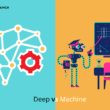
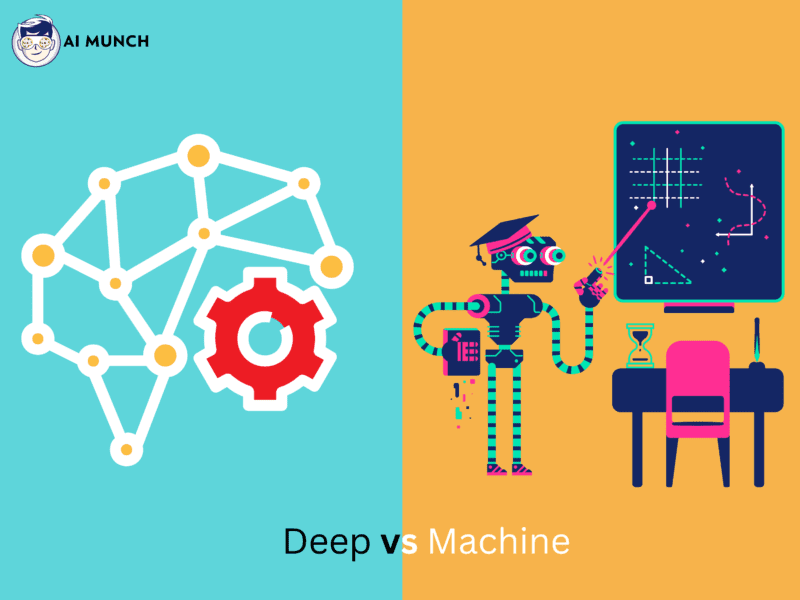



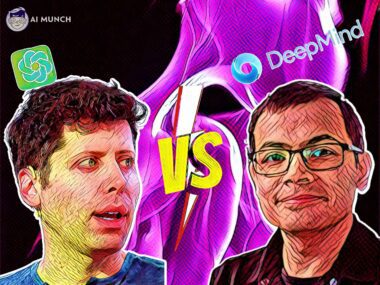

2 comments